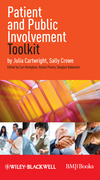Patient and Public Involvement ToolkitISBN: 978-1-4051-9910-0
Paperback
112 pages
March 2011, BMJ Books
 |
||||||
Chapter 1 Introduction.
The toolkit series.
Aim of this toolkit.
Why have a PPI toolkit?
The language of PPI.
Getting started.
Levels of PPI.
Chapter 2 What is patient and public involvement?
Why bother with PPI?
Why is PPI growing in health and social care?
Changes in PPI legislation.
How does PPI help organizations and services and care change?
Improving health services.
Improving health research.
Global networks.
Monitoring of health services.
Developing health organizations.
Developing an organizational strategy for PPI.
Defi ne structures within your organization.
Defi ne structures outside your organization.
Four ways to develop PPI.
Chapter 3 How to conduct effective PPI.
Searching for literature about involvement.
Searching the grey literature for PPI publications.
PPI search terms.
Searching and citing issues in PPI.
Involving the right people.
PPI methods and tools.
Reviewing documents.
Designing a questionnaire for a survey.
Running a focus or discussion group.
Running a workshop.
Practical considerations.
An icebreaker: tree types.
Exhibitions and road shows.
Interviews.
Chapter 4 Building relationships.
Recruitment and networking.
Methods for recruitment.
Support and training for participants and professionals.
Interpersonal skills: running effective meetings and workshops.
Role of chairperson or facilitator.
Dealing with diffi cult situations and managing conflict.
Being inclusive.
Avoiding the pitfalls.
Online communication in PPI.
Communicating in advance.
Chapter 5 Evaluation of PPI.
Evaluating PPI methods and process.
Evaluating the impact of PPI on a service or project.
Evaluating the impact of PPI on the people who took part.
Chapter 6 The future of PPI.
Allocation of resources and better use of resources.
Accessibility of services.
Health professionals working with patients and the public.
Developing trust and credibility between the public and health organizations.
Improving quality of care and reducing harm.
Final thoughts.
Conclusions.
Index.



